Resource Center
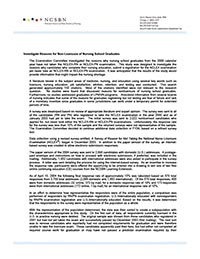
Investigate Reasons for Non-Licensure of Nursing School Graduates
This NCSBN led study was designed to investigate the reasons why candidates who complete their nursing education, submit a registration for the NCLEX examination yet never take an NCLEX-RN® or NCLEX-PN® examination.
2004 | Publications
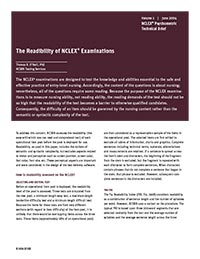
The Readability of the NCLEX Examination
NCSBN assesses the readability (the ease with which one can read and comprehend text) of each operational NCLEX pool of items before the pool is deployed for use.
2004 | Publications
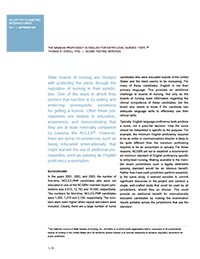
The Minimum Proficiency in English for Entry-Level Nurses: TOEFL(TM)
State boards of nursing are charged with protecting the public through the regulation of nursing in their jurisdiction. One of the ways in which they perform that function is by setting and enforcing prerequisite conditions for getting a license.
2004 | Publications
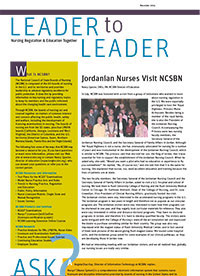
Fall 2004 Leader to Leader
- A summary of the NCBSN White Paper on State-of-the-Art Approval/Accreditation Processes at Boards of Nursing is provided
- Learn about the National Forum for Nursing Practice Doctorate
- NCSBN is visited by nurses and state officials from Jordan, including Her Royal Highness Princess Muna Al-Hussein, President of the Jordanian Nursing Council
2004 | Magazines
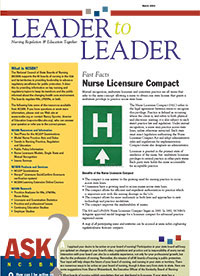
Spring 2004 Leader to Leader
- Learn how the Nurse Licensure Compact (NLC) allows a nurse to practice across state lines with one multistage license
- Get tips on becoming politically active in order to improve health care
- NCSBN to conduct a study on regulatory oversight of chemically dependent nurses
2004 | Magazines

Ethics in practice: NCLEX results to disclose or not disclose
Individuals and organizations involved in nursing regulation, education, and practice can effectively increase their influence related to nursing regulation and improving health care in several ways.
2004 | Research Item
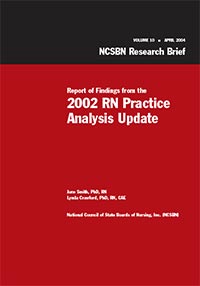
Report of Findings from the 2002 RN Practice Analysis (Vol. 10)
This practice analysis describes and compares the practice characteristics and activities of newly licensed registered nurses (RNs). The empirical findings were used to evaluate the 2004 NCLEX-RN Test Plan. (© 2003)
2003 | Research Item
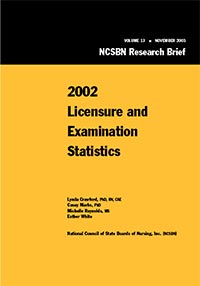
2002 Nurse Licensee Volume and NCLEX Examination Statistics (Vol. 13)
This annual publication provides national and state summary data of Member Boards’ licensure activities, as well as data on candidate performance on the NCLEX-RN and NCLEX-PN examinations. (© 2003)
2003 | Publications
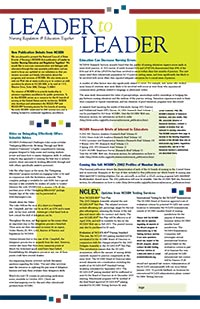
Fall 2003 Leader to Leader
- Read about the education initiatives at NCSBN
- Learn about errors and transition issues for entry-level nurses
- A summary of the 2002 NCSBN position paper on the education of advanced practice nurses is provided
2003 | Magazines
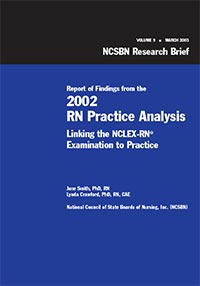
Report of Findings from the 2002 RN Practice Analysis Update (Vol. 9)
This practice analysis describes and compares the possible differences in the entry-level practices of newly licensed associate and baccalaureate degree nurses. (© 2004)
2003 | Exams Research
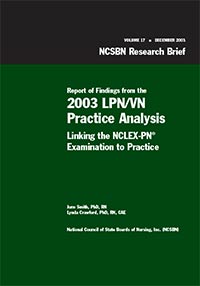
Report of Findings from the 2003 LPN/VN Practice Analysis: Linking the NCLEX-PN to Practice (Vol. 17)
This practice analysis describes and compares the practice characteristics and activities of newly licensed practical/vocational nurses (LPN/VNs). The empirical findings will be used to evaluate the 2005 NCLEX-PN Test Plan (© 2003).
2003 | Exams Research
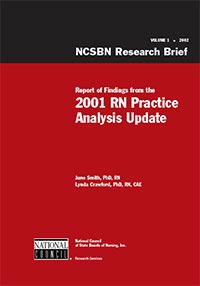
Report of Findings from the 2001 RN Practice Analysis Update (Vol. 1)
The purpose of this study is discovery of any potential differences between the entry-level practices of graduates of associate degree and baccalaureate degree RN educational programs (© 2002).
2002 | Research Item
